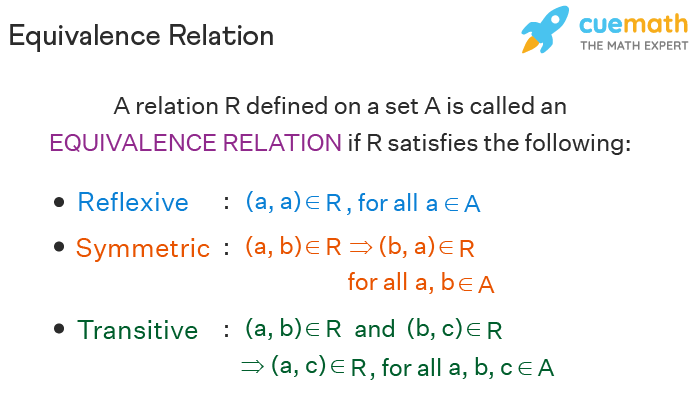Equivalence Relation
Equivalence relation defined on a set in mathematics is a binary relation that is reflexive, symmetric, and transitive. A binary relation over the sets A and B is a subset of the cartesian product A × B consisting of elements of the form (a, b) such that a ∈ A and b ∈ B. A very common and easy-to-understand example of an equivalence relation is the 'equal to (=)' relation which is reflexive, symmetric and transitive.
As the name suggests, two elements of a set are said to be equivalent if and only if they belong to the same equivalence class. In this article, we will understand the concept of equivalence relation, class, partition with proofs and solved examples.
| 1. | What is Equivalence Relation? |
| 2. | Proof of Equivalence Relation |
| 3. | Definitions Related to Equivalence Relation |
| 4. | FAQs on Equivalence Relation |
What is Equivalence Relation?
An equivalence relation is a binary relation defined on a set X such that the relation is reflexive, symmetric and transitive. If any of the three conditions (reflexive, symmetric and transitive) does not hold, the relation cannot be an equivalence relation. The equivalence relation divides the set into disjoint equivalence classes. Any two elements of the set are said to be equivalent if and only if they belong to the same equivalence class. An equivalence relation is generally denoted by the symbol '~'.
Equivalence Relation Definition
A relations in maths for real numbers R defined on a set A is said to be an equivalence relation if and only if it is reflexive, symmetric and transitive. They are often used to group together objects that are similar, or equivalent. It satisfies the following conditions for all elements a, b, c ∈ A:
- Reflexive - R is reflexive if (a, a) ∈ R for all a ∈ A
- Symmetric - R is symmetric if and only if (a, b) ∈ R ⇒ (b, a) ∈ R for all a, b ∈ A
- Transitive - R is transitive if and only if (a, b) ∈ R and (b, c) ∈ R ⇒ (a, c) ∈ R for all a, b, c ∈ A

The equivalence relation involves three types of relations such as reflexive relation, symmetric relation, transitive relation.
Examples of Equivalence Relation
- 'Is equal to (=)' is an equivalence relation on any set of numbers A as for all elements a, b, c ∈ A, we have a = a, a = b ⇒ b = a, and a = b, b = c ⇒ a = c. This implies (=) is reflexive, symmetric and transitive.
- 'Is similar to (~)' defined on the set of triangles: It is reflexive, symmetric, and transitive.
- 'Has the same birthday' defined on the set of people: It is reflexive, symmetric, and transitive.
- 'Is congruent to' defined on the set of triangles is an equivalence relation as it is reflexive, symmetric, and transitive.
- 'Congruence modulo n (≡)' defined on the set of integers: It is reflexive, symmetric, and transitive.
- 'Has the same absolute value' defined on the set of real numbers is an equivalence relation as it is reflexive, symmetric, and transitive.
Proof of Equivalence Relation
To understand how to prove if a relation is an equivalence relation, let us consider an example. Define a relation R on the set of natural numbers N as (a, b) ∈ R if and only if a = b. Now, we will show that the relation R is reflexive, symmetric and transitive.
- Reflexive Property - Since every natural number is equal to itself, that is, a = a for all a ∈ N ⇒ (a, a) ∈ R for all a ∈ N. Hence, R is reflexive.
- Symmetric Property - For a, b ∈ N, let (a, b) ∈ R ⇒ a = b ⇒ b = a ⇒ (b, a) ∈ R. Since a, b are arbitrary, R is symmetric.
- Transitive Property - For a, b, c ∈ N, let (a, b) ∈ R and (b, c) ∈ R ⇒ a = b and b = c ⇒ a = c (as numbers equal to the same number are equal to one another) ⇒ (a, c) ∈ R. Since a, b, c are arbitrary, R is transitive.
Since R, defined on the set of natural numbers N, is reflexive, symmetric, and transitive, R is an equivalence relation.
Proving a Relation is Not an Equivalence Relation
We have seen how to prove an equivalence relation. Now, we will consider an example of a relation that is not an equivalence relation and find a counterexample for the same. Define a relation R on the set of integers as (a, b) ∈ R if and only if a ≥ b. We will check for the three conditions (reflexivity, symmetricity, transitivity):
- Reflexivity - As every integer is equal to itself, that is, a = a for all a ∈ Z, it satisfies a ≥ a for all a ∈ Z. This implies (a, a) ∈ R for all a ∈ Z. Hence, R is reflexive.
- Symmetricity - For a, b ∈ Z, let (a, b) ∈ R ⇒ a ≥ b. This does not imply that b ≥ a. For example, 12 ≥ 9 but 9 is not greater than or equal to 12. This implies R is not symmetric.
We do not need to check for transitivity as R is not symmetric ⇒ R is not an equivalence relation.
Definitions Related to Equivalence Relation
Now, we will understand the meaning of some terms related to equivalence relation such as equivalence class, partition, quotient set, etc. Consider an equivalence relation R defined on set A with a, b ∈ A.
- Equivalence Class - An equivalence class is a subset B of A such (a, b) ∈ R for all a, b ∈ B and a, b cannot be outside of B. Mathematically, an equivalence class of a is denoted as [a] = ∈ A: (a, x) ∈ R> which contains all elements of A which are related 'a'. All elements of A equivalent to each other belong to the same equivalence class. In other words, all elements belonging to the same equivalence class are equivalent to each other.
- Partition - A partition of set A is a non-empty set of disjoint subsets of A such that no element of A is in two subsets of A and elements belonging to the same subset are related to each other. The union of subsets in the partition is equal to set A.
- Quotient Set - A quotient set is a set of all equivalence classes of an equivalence relation denoted by A/R = ∈ A>
Related Topics
- Transitive Property of Congruence
- Antisymmetric Relation
- Relations and Function Worksheets
Important Notes on Equivalence Relation
- An equivalence relation is a binary relation defined on a set X such that the relation is reflexive, symmetric and transitive.
- The equivalence relation divides the set into disjoint equivalence classes.
- All elements belonging to the same equivalence class are equivalent to each other.
Examples on Equivalence Relation
- Reflexive Property - For a symmetric matrix A, we know that A = A T . Therefore, (A, A) ∈ R. ⇒ R is reflexive.
- Symmetric Property - For A, B ∈ S, we have A = A T and B = B T . Let (A, B) ∈ R ⇒ A = B T . We know that B = (B T ) T = A T (As A = B T ) ⇒ B = A T ⇒ (B, A) ∈ R. Therefore, R is symmetric.
- Transitive Property - For A, B, C ∈ S, we have A = A T , B = B T and C = C T . Let (A, B) ∈ R and (B, C) ∈ R ⇒ A = B T and B = C T . We have A = B T = B = C T ⇒ A = C T ⇒ (A, C) ∈ R. Therefore, R is transitive.
Since R is reflexive, symmetric and transitive, R is an equivalence relation.
- Reflexivity - For any real number a, we know that |a| = |a| ⇒ (a, a) ∈ F, for all a ∈R. Therefore, F is reflexive.
- Symmetricity - For a, b ∈R, let (a, b) ∈ F ⇒ |a| = |b| ⇒ |b| = |a| ⇒ (b, a) ∈ F. Since a, b are arbitrary, F is symmetric.
- Transitivity - For a, b, c ∈R, let (a, b) ∈ F and (b, c) ∈ F ⇒ |a| = |b| and |b| = |c| ⇒ |a| = |c| ⇒ (a, c) ∈ F. Since a, b, c are arbitrary, F is transitive.
Since F is reflexive, symmetric and transitive, F is an equivalence relation.
View Answer >

Great learning in high school using simple cues
Indulging in rote learning, you are likely to forget concepts. With Cuemath, you will learn visually and be surprised by the outcomes.
Practice Questions
Check Answer >
FAQs on Equivalence Relation
What is Equivalence Relation in Maths?
An equivalence relation is a binary relation defined on a set X such that the relations are reflexive, symmetric and transitive. If any of the three conditions (reflexive, symmetric and transitive) does not hold, the relation cannot be an equivalence relation.
What is the Smallest Equivalence Relation?
For any set A, the smallest equivalence relation is the one that contains all the pairs (a, a) for all a ∈ A. Equivalence relations defined on a set in mathematics are binary relations that are reflexive relations, symmetric relations, and transitive reations.
How do you write an Equivalence Class of an Equivalence Relation?
An equivalence class is a subset B of A such (a, b) ∈ R for all a, b ∈ B and a, b cannot be outside of B. Mathematically, an equivalence class of a is denoted as [a] = ∈ A: (a, x) ∈ R> which contains all elements of A which are related 'a'.
What are the Three Conditions to Prove an Equivalence Relation?
A relation R defined on a set A is said to be an equivalence relation if and only if it is reflexive, symmetric and transitive. It satisfies the following conditions for all elements a, b, c ∈ A:
- Reflexive - R is reflexive if (a, a) ∈ R for all a ∈ A
- Symmetric - R is symmetric relations if and only if (a, b) ∈ R ⇒ (b, a) ∈ R for all a, b ∈ A
- Transitive - R is transitive if and only if (a, b) ∈ R and (b, c) ∈ R ⇒ (a, c) ∈ R for all a, b, c ∈ A
Is an Empty Relation an Equivalence Relation?
An empty relation on an empty set is an equivalence relation but an empty relation on a non-empty set is not an equivalence relation as it is not reflexive.
What is an Equivalence Relation Example in Real-Life?
A real-life example of an equivalence relation is: 'Has the same birthday as' relation defined on the set of all people. It satisfies all three conditions of reflexivity, symmetricity, and transitive relations.



